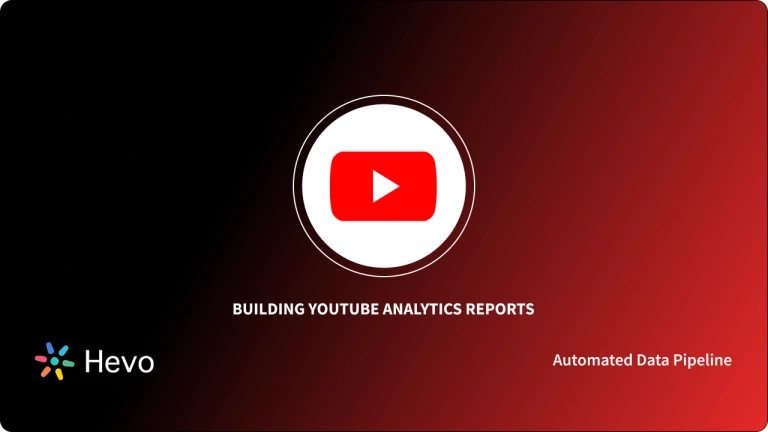Do you use YouTube as a video sharing platform? Are you trying to load data from Youtube Analytics? If yes, then you are in the right place. YouTube is a premium platform for video sharing. It is widely used by the organisations to create a channel and upload videos of different kinds. YouTube also provides analytics service to keep a track of crucial metrics and statistics. In this blog, you will learn about the available tools and basics of creating a YouTube Analytics Dashboard.
Table of Contents
What is a Dashboard?
Dashboards are a collection of widgets that give you a bird’s eye view of what’s happening in your BI (Business Intelligence) and analytics process. It shows you reports and metrics on a single screen and lets you monitor and dig deeper into many metrics at once. Dashboards must be easy to create, customize, export and share. A good Dashboard must highlight key trends to aid decision making and should be simple enough to let non-technical users participate easily.
What Metrics Can you Track Using Youtube Analytics Dashboard?
In your YouTube Analytics dashboard, you can track the following key metrics to evaluate the performance of your videos and channel:
- Demographics: Information about the age, gender, and other demographic details of your audience.
- Views: The total number of times your videos have been watched.
- Watch Time: The total amount of time viewers have spent watching your videos.
- Subscribers: The number of subscribers gained or lost over a specific period.
- Engagement:
- Likes/Dislikes: The number of likes and dislikes on your videos.
- Comments: The number of comments received on your videos.
- Shares: How often your videos have been shared by viewers.
- Audience Retention: The percentage of a video that viewers watch on average.
- Impressions: The number of times your video thumbnails were shown to viewers.
- Click-Through Rate (CTR): The percentage of viewers who clicked on your video after seeing the thumbnail.
- Traffic Sources: Information on where your views are coming from (e.g., YouTube search, external websites, social media).
- Top Geographies: The geographic locations where your videos are most viewed.
- Devices: Insights into the devices your audience is using to watch your videos (e.g., mobile, desktop, tablet).
- Revenue (for monetized channels): Data on earnings from ads, YouTube Premium revenue, super chats, memberships, and more.
Streamline your YouTube Analytics by migrating data seamlessly to your preferred data warehouse with Hevo! Automate real-time synchronization, consolidate insights from multiple platforms, and make data-driven decisions faster. Take control of your YouTube strategy today by:
- Integrating data from 150+ sources(60+ free sources).
- Simplify data mapping and transformations using features like drag-and-drop.
- Easily migrate different data types like CSV, JSON, etc., with the auto-mapping feature.
Join 2000+ happy customers like Whatfix and Thoughtspot, who’ve streamlined their data operations. See why Hevo is the #1 choice for building modern data stacks.
Get Started with Hevo for FreeMethod 1: YouTube Analytics Dashboard Using Google Data Studio
As Google owns YouTube, the Google Data studio has inbuilt features to create the Analytics Dashboard(s) using your Youtube data. So, why build anything from scratch if there are existing tools available.
Let’s see what are the steps to create YouTube Analytics Dashboard using Google Data Studio:
Step 1: Go to Google Data Studio and from existing templates (Templates Gallery) select the “Youtube Channel Report”. Click on the “USE TEMPLATE” to use the default template.
Step 2: Click on “Add Data” on the top menu. In the available sources that appear on the screen, add your YouTube data via “YouTube Analytics” data connector. If required, allow Data studio to access your YouTube data.
By clicking on the YouTube Analytics connector, it will show your channel(s). On selecting your channel, it shows all the available fields that hold your channel data.
Within a few seconds, your selected template will load with data from one of your Channels.
The above image is from one of my channels, there is not much data here, but it would suffice for our demo purpose.
The default template shows your Views/Avg Watch Time/Shares on the top part and data about Likes/Subscriptions/Comments in the middle part. The bottom part shows some maps depicting the geographies (countries/states) from where your traffic primarily originates.
From the top menu, you can add a chart of your choice from “Add a Chart”. On the right-side panel, you can change properties, and customize your template. Many elements like Likes/Subscriptions/Comments can be customized.
Many new controls, data elements (dropdowns/sliders/date ranges/fields/metrics/data source/filters) and style elements (font/annotations/chart types/colors/layout) can be changed. You can add new pages to this report. Adding a new page allows you to add the data that will be used, the operations to apply, the graphs to display the analytical results. It just takes a few minutes to get your first YouTube Analytics data Dashboard in Google Data studio.
Method 2: Youtube Analytics Dashboard Using Google Analytics Studio
While the default dashboard is good for beginners and small projects, often you will feel the need to create a dashboard for your specific needs. The real power of a Dashboard is its ability to customize and delve deeper into facts. In this section, you will set up a new dashboard with the help of available tools in Google Analytics Studio.
You can track the traffic that’s coming to your YouTube channel on Google Analytics. If you have a lot of traffic on your YouTube channel, Google Analytics can show you some useful insights like from where your YouTube traffic is coming from, traffic tracking e.g. if someone is using your video, visiting your website or clicking an ad.
Word of caution – Google Analytics will not tell you which particular video a user watched unless you add a UTM tag.
Let’s see what are the steps to create YouTube Analytics Dashboard using Google Analytics:
Step 1: Inside Google Analytics Studio – click “Create” and specify an Account name.
Step 2: In the next screen, specify a “property name”.
The property represents your business web and/or app data, in this case, “YouTube Data”. You can add up to 4 properties. Also, specify your Industry, Business size, Time Zone and Currency, etc.
Google will assign a unique Tracking ID to this property, copy and save it somewhere.
Step 3: Accept the licensing terms that follow.
Step 4: Create a filter that allows YouTube data only to your newly created view.
Copy your unique Tracking ID.
Step 5: Next, you can add Views and Property.
Step 6: Next, you will need to connect this with our YouTube data.
Inside your YouTube settings, go to “View Additional Features”, then click on “Channel –> Advanced” and scroll down. Specify your “Google Analytics Tracking ID”.
Now, your YouTube data will migrate into Google Analytics. This data will be based on your channels (individual video stats will not be shown). It gives you an eagle-eye view of your YouTube activity.
Step 7: Go back to your recently created property/filter in Google Analytics, and there you will see a minimal Dashboard.
Step 8: By clicking “Acquisition” in the left menu bar, you will know how users find your channel. It is useful when you try to find new ways to attract visitors and consolidate existing ones.
“Behaviour –> Site Content –> All Pages”, shows you unified statistics, like Pageviews/Time on page/Bounce rate, etc. about all your channels.
Here you can know your popular channels and how they are helping you achieve your goals.


Conclusion
Setting up your YouTube Analytics dashboard is a crucial step in understanding how your content is performing and optimizing your channel for growth. By tracking key metrics such as views, engagement, audience retention, and revenue, you gain valuable insights into your audience’s behavior and preferences. This data empowers you to refine your content strategy, improve video performance, and ultimately grow your YouTube channel.
Hevo simplifies the process by automating the migration of your YouTube Analytics data into your preferred data warehouse, ensuring seamless integration and real-time synchronization. With Hevo, you can consolidate your analytics across multiple platforms, streamline reporting, and make data-driven decisions faster.
Ready to unlock the full potential of your YouTube Analytics? Start migrating your data with Hevo today and take control of your content strategy!
FAQs on Youtube Analytics Dashboard
1. How do I see my YouTube Analytics?
Go to YouTube Studio, click on “Analytics” in the left-hand menu to view your channel’s performance, audience, engagement, and revenue data.
2. What is a YouTube Analytics dashboard?
The YouTube Analytics dashboard provides key metrics like views, watch time, subscribers, and revenue, allowing creators to track and improve their content strategy.
3. What is the income of YouTube channel?
YouTube income varies based on factors like ad revenue, views, engagement, channel type, and monetization features such as memberships or sponsorships.









